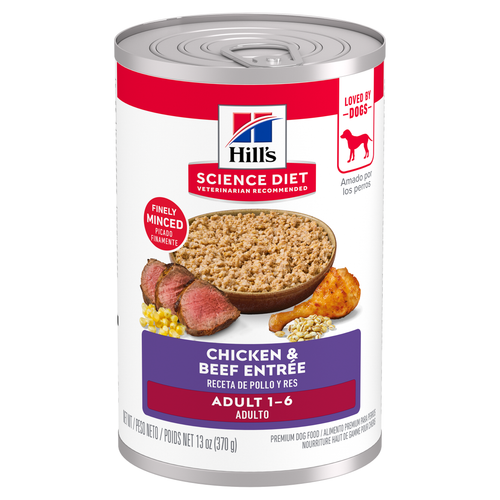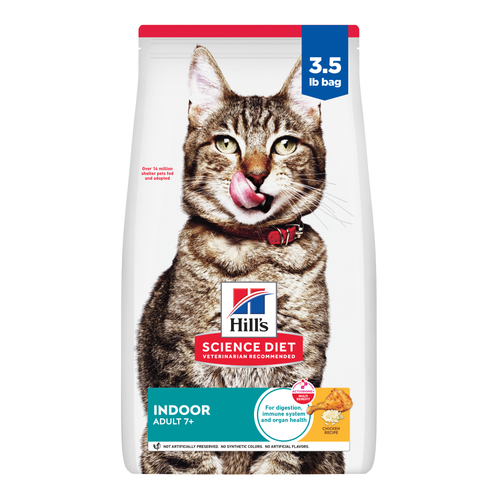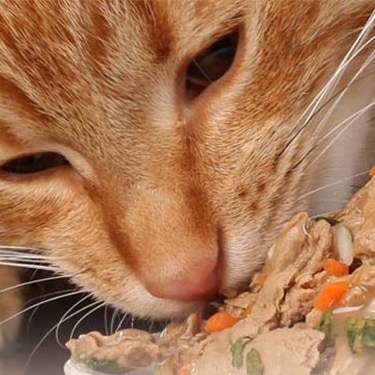
-
Find the right food for your petTake this quiz to see which food may be the best for your furry friend.Find the right food for your petTake this quiz to see which food may be the best for your furry friend.Featured products
 Hill's Science Diet Adult Chicken & Beef Entrée Dog Food
Hill's Science Diet Adult Chicken & Beef Entrée Dog FoodChicken & Beef Entrée in a delicious loaf with complete & balanced nutrition to help keep adult dogs active and healthy
Shop Now Adult Large Breed Chicken & Barley Recipe Dog Food
Adult Large Breed Chicken & Barley Recipe Dog FoodSupports healthy joints, lean muscle, and beautiful coat for large breed dogs
Shop Now Adult Chicken & Barley Recipe Dog Food
Adult Chicken & Barley Recipe Dog FoodSupports lean muscle and beautiful coat for adult dogs
Shop NowFeatured products Adult 7+ Indoor Chicken Recipe Cat Food
Adult 7+ Indoor Chicken Recipe Cat FoodSupports energy level and beautiful fur in mature indoor cats
Shop Now Adult Turkey & Liver Entrée Cat Food
Adult Turkey & Liver Entrée Cat FoodPrecisely balanced nutrition with the delicious taste of minced turkey & liver to help fuel the energy needs of cats during the prime of their life
Shop Now Senior Vitality Adult 7+ Tuna & Vegetables Stew
Senior Vitality Adult 7+ Tuna & Vegetables StewImproves Everyday Ability to Get Up & Go
Shop Now -
Dog
- Dog Tips & Articles
-
Health Category
- Weight
- Food & Environmental Sensitivities
- Urinary
- Digestive
- Joint
- Kidney
-
Life Stage
- Puppy Nutrition
- Adult Nutrition
- Senior Nutrition
Cat- Cat Tips & Articles
-
Health Category
- Weight
- Skin & Food Sensitivities
- Urinary
- Digestive
- Kidney
-
Life Stage
- Kitten Nutrition
- Adult Nutrition
Featured articles How to Properly Mix Wet & Dry Pet Foods
How to Properly Mix Wet & Dry Pet FoodsAn Orange cat eating from a bowl filled with mixed food
Read More The Science Behind Our Love for Pets
The Science Behind Our Love for PetsLearn the scientific reasons why we have such strong connections with our pets, and what science says about the love between humans and our furry friends.
Read More What Is Littermate Syndrome? Pet Adoption Guide
What Is Littermate Syndrome? Pet Adoption GuideLearn more about littermate syndrome in dogs and cats and how to successfully navigate adoption and early socialization processes.
Read More -


If you notice a lump on your cat's belly after abdominal surgery, you may be worried that it's a hernia. While a cat hernia after being spayed is possible, swelling on your cat's stomach could be a number of other things — but there's usually no reason to worry.
Read on to learn more about the different kinds of hernias, other reasons for abdominal lumps and bumps in cats, and when to seek veterinary care.
What Is a Cat Hernia?
According to the Merck Veterinary Manual, hernias of the abdominal wall are common in all domestic species, and cats are no exception. Hernias are defects, or holes, in the walls within the cat's body that separate one part from the other. An example of one of these "walls" is the abdominal wall that keeps your cat's abdominal organs in place and separate from tissue and fat directly underneath the skin. Hernias are often classified by location, including:

- Umbilical hernias: These range in size from barely detectable to quite large. They may contain fat from the cat's belly cavity, or in more severe cases, intestines. The most commonly seen hernia in cats, these occur when the abdominal wall has a hole in it. They may be discreet, but when the cat stands on all fours, a bubble-like swelling may appear as fat or intestines from the abdomen move into this "pocket."
- Inguinal hernias: Also known as scrotal hernias, these are less common in cats and involve a hole through the abdomen through a small canal in the groin area. Inguinal hernias can occur in both females and males.
- Diaphragmatic hernias: Even more rare, there are several hernias that can occur between the abdomen and chest cavity by the diaphragm. They are often seen in kitties that have been hit by a car, though some cats may be born with them.
Hernias can vary in severity but are often congenital, or present at birth, especially in kittens. According to a journal in VetRecord, there is a genetic and developmental basis for umbilical hernias in cats, as well as dogs. Alternatively, hernias can occur at various points throughout a cat's life. Traumatic hernias may be caused by events such as a difficult birth or a physical trauma. In some cases, a hernia can develop after surgery.
Diagnosing and Treating a Cat Hernia
Hernias are easily diagnosed as your veterinarian will usually be able to feel the defect and gently replace the contents that have shifted into their hernia's "pouch." There are a few cases where an ultrasound or radiographs (X-rays) are necessary if the diagnosis is not clear based upon palpation.
For most minor hernias, it is generally safe to keep an eye on the hernia, making sure it doesn't grow until your vet can repair it surgically. Surgical repair for kittens with hernias will usually be scheduled for the time of the spay or neuter surgery, so the patient only has to undergo anesthesia and recovery a single time. As long as the cat is doing well and behaving normally at home, a hernia is not an emergency.

If the hernia is quite sizable or enlarges, it isn't safe to wait. In this case, the hernia must be addressed soon to avoid risking the abdominal cavity contents becoming trapped or twisted, compromising the cat's blood supply. This can lead to a life-threatening situation. A cat may be in critical condition because of a severe hernia, though this is uncommon.


Tasty Tips
When You Notice Lumps After Surgery
Post-surgical swelling is often benign but may need further examination by your vet. Here are some of the most common reasons for swelling after surgery:
- Surgical cutting of tissue creates localized inflammation at the site of the incision. Some minor swelling is expected and is part of the body's healing process. Major swelling is atypical and requires immediate attention as it may indicate that the internal sutures have not held and a traumatic hernia has occurred, that your cat has developed a seroma (a swelling of fluid at the surgical site) or that your cat has an infection.
- Suture material is foreign to the body, and while you may only see one layer of sutures on a cat's body, there are three layers of sutures involved in closing your cat's abdomen. If you see a small bump at either end of the incision line, it may simply be the knot of the sutures underneath the skin, or where the vet closes the incision line with a technique called "burying the sutures." A cat's body will react to the suture, and some cats can react more than others. It is usually not a concern as long as the incision area isn't red, irritated, leaking, painful or very swollen.
- As the body repairs the surgical incision, it lays down more tissue, generally referred to as scar tissue. This thickening is often noticeable by touch after abdominal surgeries. It may resemble a firm, bumpy line or a small rope across the incision.
- Finally, there may be reasons for lumps that are not associated with the surgery at all. Abdominal surgery involves shaving a cat's stomach, so different bumps that were previously hidden by fur may now be revealed.
Remember, if you suspect your furry friend has developed a hernia after being spayed or neutered, contact your vet. They will most likely recommend a recheck to determine if it is a hernia or if there is another explanation for the abdominal swelling. Hernias have a great prognosis and are typically resolved with surgery.


Dr. Laci Schaible is a small animal veterinarian, veterinary journalist, and a thought leader in the industry. She received her Doctor of Veterinary Medicine from Texas A&M University and her Masters in Legal Studies from Wake Forest University.
Related products

Delectable chunks with tender chicken smothered in a rich gravy

Precisely balanced nutrition with the delicious taste of minced turkey & liver to help fuel the energy needs of cats during the prime of their life

Improves Everyday Ability to Get Up & Go

Supports energy level and beautiful fur in mature indoor cats
Related articles

Discover how to train your cat, starting with very basic first steps that both reward good behavior and discourage the bad.

When you adopt a cat, you don't just gain a best friend; you also save her life. Here's why getting a cat from a local animal shelter makes so much sense.

Discover which cat toys games your feline friend might like, and how they are great sources of exercise. Explore our library of articles to learn more.

Learn how to litter train a kitten with this guide to potty training, including when to start litter training kittens and troubleshooting tips.

Put your cat on a diet without them knowing
Our low calorie formula helps you control your cat's weight. It's packed with high-quality protein for building lean muscles, and made with purposeful ingredients for a flavorful, nutritious meal. Clinically proven antioxidants, Vitamin C+E, help promote a healthy immune system.
Put your cat on a diet without them knowing
Our low calorie formula helps you control your cat's weight. It's packed with high-quality protein for building lean muscles, and made with purposeful ingredients for a flavorful, nutritious meal. Clinically proven antioxidants, Vitamin C+E, help promote a healthy immune system.

